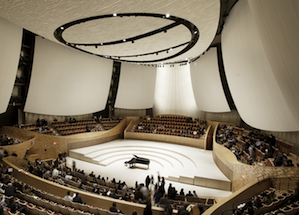
Photo by Aislinn Weidele
Stephen Hinton, Denning Family Director of the Stanford Arts Institute, has a fascinating essay in the splendid inaugural issue of StanfordLive magazine about the antecedents of Bing Concert Hall's architecture and acoustical design, pointing to the Hans Scharoun-Lother Cremer creation of the Berlin Philharmonie in 1963. (The article, correctly, doesn't go into ancient forms of theater-in-the-round preceding even the Colisseum.)
Bing Hall acoustician Yasuhisa Toyota adapted the Berlin model for several of his halls, including Suntory Hall in Tokyo (1986), Walt Disney Concert Hall in Los Angeles (2003), and New World Center in Miami (2011). Hinton quotes Scharoun's explanation for the Philharmonie design in an address at the hall's unveiling:
"The construction follows the image of a landscape," Scharoun said. "The auditorium is conceived as a valley, and there at its floor, the orchestra resides, surrounded by the rising 'terraces' of a vineyard.The ceiling encounters this ‘landscape’ like a ‘skyscape.’ Formally, it has the effect of a tent.” Proceeding from the notion "that people today, as in all ages, form a circle when improvised music is performed," the architect wanted to "transfer this natural occurrence, comprehensible to all psychologically as well as musically, to the concert hall."
Within the metaphorical setting of a natural idyll, in which the orchestra and conductor are “completely enveloped by their audience,” he was envisaging a place in which, as he said, “There is no opposition of ‘producers’ and ‘consumers’; rather, a community of listeners is grouped in a dynamic way and on various levels around the orchestra.”

